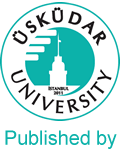Years
2020
Categories
Authors
ARTICLES
Original Article
THE DEVELOPMENT OF A FUZZY LOGIC MODEL-BASED SUICIDE RISK ASSESSMENT TOOL
Turkish Title : THE DEVELOPMENT OF A FUZZY LOGIC MODEL-BASED SUICIDE RISK ASSESSMENT TOOL
Ayhan Fatma,Üstün Besti,Ergüzel Türker Tekin
JNBS, 2020, 7(3), p:152-159
The purpose of the research was to develop a fuzzy logic model-based risk assessment tool and to determine the views of health professionals working in community mental health centers concerning this. A methodological method was employed in developing the fuzzy logic model-based risk assessment tool, and the qualitative research method was used to elicit attitudes toward it. In the first stage, the suicide risk assessment tool was developed. In second stage the health professionals used the suicide risk assessment tool for four weeks. Feedback regarding health professionals’ opinions of the suicide risk assessment tool was then elicited handling a semi-structured reportage form, and data were investigate handling descriptive analysis. Health professionals reported powerful aspects making the suicide risk assessment tool a functional, practical, comprehensive, and highly applicable guideline. Participants also recommended the addition to the results screen of a chart showing the course of the suicide risk assessment, and that the reliability and validity of the tool be confirmed. In conclusion, health professionals expressed positive opinions regarding the scope of the suicide risk assessment tool and its measurement of that risk. Following confirmation of its reliability and validity, it may be useful for the fuzzy logic-based suicide risk assessment form to be integrated into and applied in the community health centers system.
The purpose of the research was to develop a fuzzy logic model-based risk assessment tool and to determine the views of health professionals working in community mental health centers concerning this. A methodological method was employed in developing the fuzzy logic model-based risk assessment tool, and the qualitative research method was used to elicit attitudes toward it. In the first stage, the suicide risk assessment tool was developed. In second stage the health professionals used the suicide risk assessment tool for four weeks. Feedback regarding health professionals’ opinions of the suicide risk assessment tool was then elicited handling a semi-structured reportage form, and data were investigate handling descriptive analysis. Health professionals reported powerful aspects making the suicide risk assessment tool a functional, practical, comprehensive, and highly applicable guideline. Participants also recommended the addition to the results screen of a chart showing the course of the suicide risk assessment, and that the reliability and validity of the tool be confirmed. In conclusion, health professionals expressed positive opinions regarding the scope of the suicide risk assessment tool and its measurement of that risk. Following confirmation of its reliability and validity, it may be useful for the fuzzy logic-based suicide risk assessment form to be integrated into and applied in the community health centers system.
| ISSN (Print) | 2149-1909 |
| ISSN (Online) | 2148-4325 |
2020 Ağustos ayından itibaren yalnızca İngilizce yayın kabul edilmektedir.


